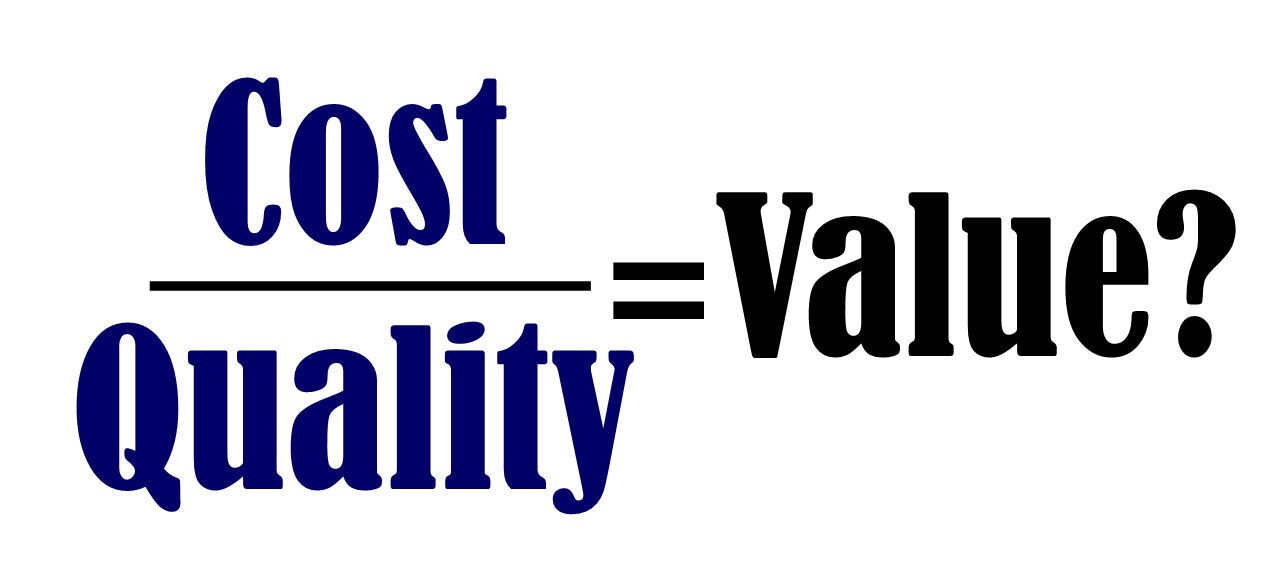Robert W. Yokl, Senior Vice President/COO, SVAH Solutions
I cringe every time I sit through a seminar/workshop or read an article that describes value analysis or “value” with the equation of Cost over Quality equals Value. Why do I cringe? Because the equation is using the incredibly subjective term “quality” to try to describe what should be a requirement for a doctor, patient, or end-user customer of your hospital, system, or IDN. Does a doctor ask for a quality instrument for his surgical case? Or does the doctor ask for an instrument that reliably meets their functional requirements exactly? Does getting a best price, standardization, or contract terms matter if the product fails to meet the requirements of the doctor which of course effects your patient outcomes? We need to better define quality into something more exacting.
OLD: Cost Over Quality = Value
Let’s look at a simple example: A hospital value analysis team performs a study on endoscopes for a capital request for a gastroenterologist. They were able to contract for the highest quality endoscopes and got great terms on the disposables. They did such a great job with the savings they brought about that they were able to buy two additional scopes with the budgeted monies. This appeared to be a win-win for the team and the doctor, which is what we strive for. However, two weeks into utilizing the new endoscopes, the team leader was notified that the doctor was unhappy with the new endoscopes that he requested because the handle grip did not meet his requirements. Basically, he was refusing to use these new endoscopes that he requested from this vendor and wanted all new ones bought ASAP.
From a performance and quality standpoint, there was nothing wrong with this product. It performed as it was intended and priced. What was the real issue here? The team and requesting doctor focused on buying the top-of-the-line, most-touted quality product in the vendors product line but the team failed to find out what the doctor’s exact functional requirements were. The doctor required a different angle grip on the endoscopes than this vendor could provide and thus rendered the product unusable to him. The team never validated the actual functional requirements of the doctor for this endoscope. A simple walk-through test of the use of the actual product would have uncovered this before the hospital purchased 16 of them. If you look at the cost/price over quality equation, this should have worked -right? But the functionality of the product did not meet the end customers’ requirements.
NEW: Cost Over Function = Value
Larry Miles, the Father of Value Analysis, defines value as follows: “When most people evaluate a product, service, or technology, they only look at the product, service, or technology’s aesthetics and not its reason for being….FUNCTION.” Larry Miles was a Value Engineer who worked for GE during the 1940’s when raw materials’ accessibility and high costs due to World War II forced GE to look for lower cost alternatives to meet their functional requirements. GE was a major manufacturer during, and of course well after, WWII. According to Miles, “Value is the lowest cost that will reliably accomplish a function used.” If you think about products, you should be thinking about function first which will help you better determine quality while improving your standardization, pricing, and utilization overall.
Is Value Analysis in Healthcare Different from Other Industries?
 I know there are many who say that value analysis in industry is different from the healthcare environment, but we are all evaluating products, services, and technologies. Does adding the words clinical or quality to value analysis change the process that you should use to evaluate the products? No matter what you are evaluating, whether it be the endomechanical instruments in healthcare or windows for a skyscraper, the common thread is that they all have functional requirements first and then you attack the cost aspects (price, standardization, sourcing, etc.) once you have defined your exact products and/or services to meet your requirements. We can use the same principles and practices to perform a VA study on a clinical product as we could on an office supply. The same goes for a clinical service as compared to a non-clinical service; the services must meet functional requirements or we don’t buy them at all.
I know there are many who say that value analysis in industry is different from the healthcare environment, but we are all evaluating products, services, and technologies. Does adding the words clinical or quality to value analysis change the process that you should use to evaluate the products? No matter what you are evaluating, whether it be the endomechanical instruments in healthcare or windows for a skyscraper, the common thread is that they all have functional requirements first and then you attack the cost aspects (price, standardization, sourcing, etc.) once you have defined your exact products and/or services to meet your requirements. We can use the same principles and practices to perform a VA study on a clinical product as we could on an office supply. The same goes for a clinical service as compared to a non-clinical service; the services must meet functional requirements or we don’t buy them at all.
Quality Equals Function and Function Equals Quality
It is obvious that my problem with the Value Equation is with the word quality and the subjective nature of how we define quality in the healthcare supply chain world. If you replace the word quality with function, then you can clearly define the use of a product, service, or technology. What does this customer require, what does that customer require, etc.? If we reliably meet our customers’ exact requirements with the products available to use in our contract and GPO portfolios at the lowest acceptable costs, then I guarantee that you will meet your quality goals exactly as well. With exacting functions, we don’t overshoot or undershoot the mark. We hit it exactly for our internal and external customers.
If we are using value analysis to solve a quality issue with a product, then more than likely the product is not meeting a functional requirement and thus creating a quality or reliability issue. We then need to find an alternative product that meets a more exacting requirement and/or added required feature that was not selected or available in the previous product.
Don’t Underestimate the Power of Value Analysis for Your Organization
Value analysis is an incredible process that, if used correctly, can help you navigate the crazy world of the products, services, and technologies of the healthcare supply chain. The principles of value analysis are universal, just like the principles of Lean, Six Sigma, and other continuous improvement systems and methods. By steering clear of subjective terms such as quality and focusing more on the aspects of products that you can clearly define like function, you will gain a whole new level of success with your cost and value creation for your organizations.





